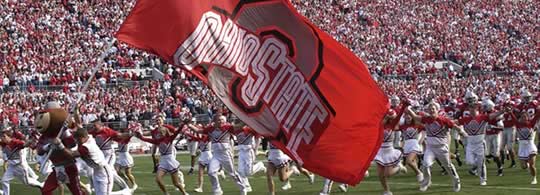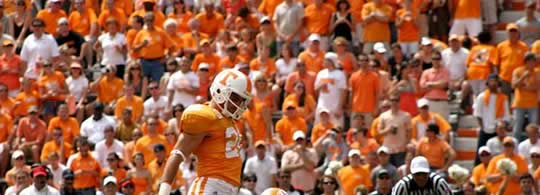The Case FOR College Sports

Recently, Newsweek ran a big article titled The Case Against College Athletic Recruiting, with the sensational subtitle claiming that U.S. universities are “misappropriating resources” on sports. Accusing some of the nation’s most revered institutions of financial malfeasance is no small thing. But are colleges really squandering the money they spend on athletics? Perhaps in some cases they are, but there’s a brain-based case to be made FOR college athletics.
First, let’s acknowledge one valid point in the Newsweek story: obscure sports that have just a few students participating, draw few spectators, and which have no great tradition of excellence, likely don’t do much for the sponsoring institution. I’ll leave the arguments about introducing diversity to the student cohort, developing leaders, etc., to others. My arguments focus primarily on the more visible sports that do attract student spectators and get off-campus exposure.
I’m sure Newsweek is correct when they state that only a few colleges and universities turn a profit on their sports, even on programs like Division I football that draw tens of thousands of spectators. So, if for most colleges sports are on the “cost” side of the ledger, the real question is what OTHER benefits the schools reap for their investment in athletics.
Branding Boost
As regular Neuromarketing readers know, I’m a believer in the importance of college branding. Schools that fail to build a strong brand will suffer in an era of declining college-age student counts and increased competition from online programs. And, in the US, college branding is driven most by sports. One measure of brand strength is revenue generated by college-branded apparel, and that list is dominated by schools known for their sports endeavors. The most recent rankings from the Collegiate Licensing Company start with Texas, Alabama, Florida, LSU, Georgia, North Carolina, Michigan, Penn State, Kentucky, and Oklahoma. All of these are fine institutions and have large student bodies, but all are big-time sports schools. Even the few academic powerhouses in the top 50 – Notre Dame at 11, Duke at 42, Stanford at 49 – have very visible sports programs. Arguably, Notre Dame and Duke are better known for football and basketball than their USNews ranking. Academic brands like Harvard and Yale don’t make the list.
According to one report, top-ranked Texas garnered $8 million in licensing revenue in 2008. That sum is nothing to sneeze at, but think about what it really means. How many UT and Longhorn t-shirts, ball caps, and so on were sold in just one year to generate $8 million in licensing fees? How many brand impressions did those items create, not just in Austin but around the nation? The University of Texas is likely generating BILLIONS of brand impressions annually from all the apparel and other items sporting their trademarks.
One could argue that such branding relates mainly to sports. It might attract more viewers to Texas games, and perhaps some sports-enthusiast high school students will choose to apply to the school. But will sports-driven branding attract the academically qualified students that every college seeks? What about the gifted violinist looking for an undergrad school? While of course a host of considerations will influence the decision of each student – program reputation, distance from home, scholarships, etc. – brand familiarity WILL have an effect.
How do we know this? Brain scans provide the evidence. In Brain Branding: The Power of Strong Brands, I described research showing that strong brands lit up areas of the brain related to “positive emotional processing and associated with self-identification and rewards.” Unfamiliar brands had no such effect, and even produced a negative emotional response.
Maize and More
College brands are always associated with colors. The Crimson Tide. Maize and Blue. Big Orange. Undoubtedly, the college color tradition dates back to pre-football symbology involving coats-of-arms, but its impact is totally modern. In Buyology, author Martin Lindstrom describes the potency of color as a branding tool. Using fMRI brain scans, researchers showed that “Marlboro red” alone was able to activate tobacco cravings. He discusses the popular show American Idol, in which Coca Cola was able to incorporate its own shade of red and achieve a big brand recognition boost even without overt logo placement.

The schools that top the licensing list all have distinctive colors and work hard to maintain the exact hue across all media and applications. Tennessee, for example, has a fairly simple approach to brand color usage. (Some schools have huge brand specification documents that are as detailed and specific as any consumer brand standard.) When you watch sports on television, you see a sea of green, red, orange, or whatever color the home team sports. It’s on the fans, the players, the field logos, and everywhere else. Watch college sports for a while and you’ll likely be able to determine who’s playing just from the colors.
The color alone becomes the branding message.

One icon’s color branding failure
Oddly, one school that fails the color test is college sports icon Notre Dame, which seems divided between its traditional blue and gold (a color notoriously hard to reproduce consistently) and Irish green. A further complicating factor is that the entire student body typically wears “The Shirt” to football games – a fundraising effort that produces a single shirt design each year and sells many thousands to students and fans. The Shirt has often deviated from official school colors, which ensures everyone will have to buy a new one each season but further muddles consistent color branding. As seen from blimp cameras, Notre Dame’s stadium is probably the least consistently colored of any major football school.
Tribalism and Group Identity
Our brains are wired to want to be part of a community. In my post about Steve Jobs turning Apple customers into fanatics, I wrote about Henri Tajfel’s experiment that shows how trivially simple it is to make people feel like they are part of one group and at the same time discriminate against other groups.

College sports are all about belonging (and often disliking others). Army needs Navy, Harvard needs Yale, Ohio State needs Michigan, and so on. The combination of organic school spirit, orchestrated cues like repetitive chants, and a hated enemy all combine to create a highly emotional experience. This encourages bonding with the school and may well be critical in solidifying long-term ties with generous alumni.
The enrollment benefits of tribalism shouldn’t be overlooked. Not long ago, a colleague of mine met with a group of newly-matriculated first year students at a large public university. To her surprise, every one said they had attended a football game at the school at some point in their life. While this no doubt reflects the fact that the school draws many regional students, I’d suggest a different interpretation: the probability that these students would apply and enroll was significantly increased by their game-day visit to the stadium. Either they were attracted by the overwhelming feeling of community, or they became actively engaged as temporary members of that community.
No college can offer every prospective student the opportunity to be part of game-day fervor. Nevertheless, being part of such an experience CAN be a potent recruiting tool and undoubtedly influences hundreds of thousands of pre-college-age students every year.
Sports and Beyond
Every school doesn’t need sports. Indeed, the vast majority of US colleges don’t have big sports programs, and never will. And even for those schools with extensive athletic offerings, all sports aren’t created equal. Is the men’s wrestling program that draws single-digit fan counts and hasn’t had a winning season in twenty years doing anything to elevate the school’s brand? Of course not.
My point here is simple (even though it took a while to make it!) – schools with highly visible team sports have to look beyond a simple athletic department profit & loss statement to determine the true ROI of their sports investment. There’s plenty of neuromarketing evidence to suggest that sports can be a potent part of an overall branding strategy and are one way to boost applications and yield.
